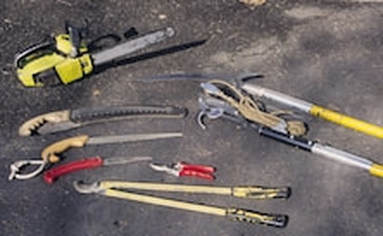TREE PRUNING - PROPERLY PRUNE YOUR TREES
Pruning your tree is a necessary yet meticulous job to do, it keeps your property hazard free and your tree healthy. There is a process to follow when properly pruning a tree; you can't merely chop down the dead branches hoping not to cause any damage. How do I properly pruning a tree, why should you do it, and when is the proper time to prune a tree?
Why Do I Need To Prune My Tree?
Pruning is strategically removing any damaged or diseased part of the tree to prevent insects and organisms from infecting the entire specimen. Pruning benefits both your property and the tree, naturally, a tree sheds any dead or decayed stems or branches, but you can't wait for the limbs to fall and damage anything it lands on. Pruning gives you the option of preemptively removing these branches or stems to prevent any unnecessary damage all while keeping your landscape clean and sharp. Trimming these will allow you to control how your tree should look as well as encourage growth.
Large Tree Species
Unlike smaller species in dendrology, pruning evergreens or deciduous requires different techniques to keep them healthy. Here are some of the procedures done while pruning these large species.
- Deciduous trees are pruned from the bottom up, specifically less than a third of the tree's actual height.
- Evergreens (or conifers) have an inactive center, somewhere needles and leaves aren't attached. It is not recommended to prune these trees to their inactive centers.
- It is best to prune deciduous trees during the winter. They produce leaves all through spring and summer. For evergreens, they grow better during spring and fall while they don't develop as much during the summer. For healthier growth, prune the evergreens in the early spring.
- When the tissue of the plant is frozen, avoid pruning the tree. It will cause undesirable cracks, breaks, or even wounds in the wood.
Proper Pruning Equipment

Using the appropriate equipment will save you from causing irreversible damage to your tree. The tools you will use to trim any branches or stems should be sharp enough to deal a clean cut. Here is a list of essential tools you will need when pruning a tree:
- Pruning saws: a curved or straight saw blade attached to a handle. Pruning saws should be sharp for them to cut large branches with ease, curved saws are easier to handle. These blades are great at high tree branches.
- Pruning shears: commonly called "hand pruners" used for cutting smaller branches
- Lopping Shears: has the appearance of a scissor with a long handle, used for cutting small branches and twigs.
- Hedge Shears: hand pruning type of shear, used for removing small branches and growth.
Wound Care After Pruning
Covering any cuts more massive than an inch will help prevent insect-borne infections. Although some trees won't need their wounds dressed at all, prevention is better than cure. Pruning paint or pruning sealer is also another way to properly seal significant cuts, in some areas of the United States they use this on Oak trees to protect them from bark beetles.
When Should You Ask for Professional Help?
Take notice of the size and location of the branches you want to remove. Are they high up? Do they appear big and heavy? In times like these calling a professional will save you from any property damage or injuries. Tree pruning company will bring with them their equipment, not to mention they are highly trained and experienced to handle any tree removal situation.
Call Nabor's Tree Service Chattanooga for a free pruning and tree care estimate.
Call Nabor's Tree Service Chattanooga for a free pruning and tree care estimate.
